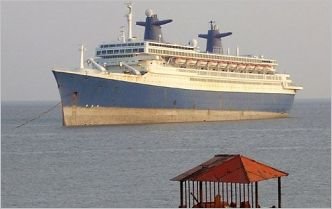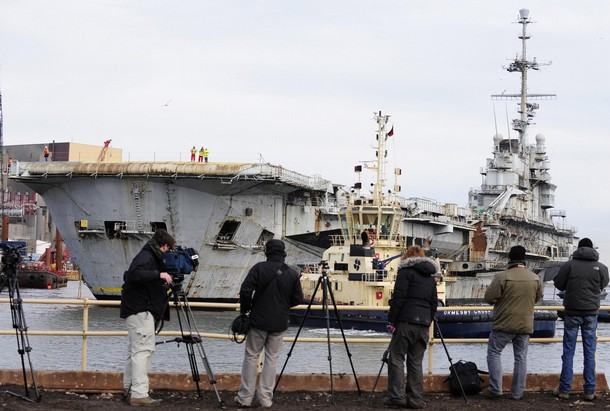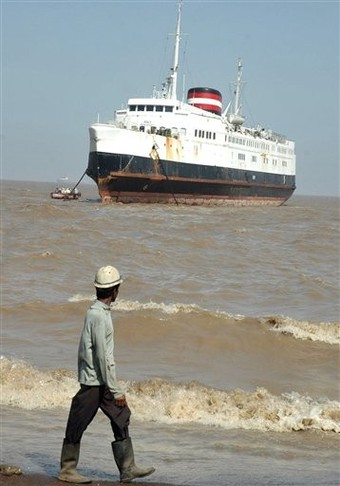THE ECONOMICS OF SHIP DISMANTLING, SHIP BREAKING AND SHIP RECYCLING
Why Ship-owners Sell Ships for Ship dismantling, shipbreaking and ship
recycling?
When the maintenance costs of the vessel start to exceed possible
revenue, or when the vessel has become unattractive for the second-hand
market.
How Ships are sold for Ship dismantling, ship breaking and ship
recycling?
Ship-owners who have decided to end the economic life of a vessel will
look for a cash buyer. The cash buyer will either be a dedicated broker
or the scrap yard operator himself. Typically, the ship will take cargo
for a final voyage to the area where the scrap yard is located. After
completion of this voyage, the ship will be brought, under its own
power, to the scrap yard where it will be dismantled. The cash buyer
pays a price in US$ per light displacement ton (ldt), which is roughly
equivalent to the steel weight of the ship.
What is normal price at Ships are sold?
For years the price has been around 150 US$/ldt (with lows around 100
US$/ldt and highs around 200 US$/ldt), but recently the strong demand
for steel scrap in China and the low supply of ships have driven prices
up to record levels of nearly 500 US$/ldt for average vessels and more
for particularly valuable ones.
What affects Ship Breaking Industry Most?
Freight market, the number of ships available for scrapping depends on
conditions on the freight market. If ships can still earn good money,
owners will not decide to send the ship for scrapping. In the past two
years, scrapping volumes were very low due to a booming and profitable
freight market.
The large majority of ships for scrapping will have to come from the
deep sea merchant fleet and will be mainly tankers and bulk carriers
(which are the “volume” segments). Other market segments, such as
warships, inland waterways vessels and offshore structures, are of
limited size and availability and so can hardly provide a steady stream
of material for large-scale recycling. The operator of a modern
recycling facility will therefore have difficulty building a business
model that fully covers its amortization costs.
What is life span of normal ship?
Ships are individual constructions with a long life-cycle and will have
undergone many repairs and maintenance in their 20-30 years of
operation. . The ships currently heading for the scrap yards were built
in the 1970s using materials that are no longer used today (e.g.
asbestos).
What is dismantling capacity in the EU?
There are facilities for larger ships mainly in Belgium, Italy and the
Netherlands, with a combined capacity of about 230,000 ldt/year, and a
multitude of smaller facilities for fishing vessels and other small
craft in most other maritime Member States. Taken together, the
existing capacity in the EU for ship dismantling may be estimated at
approximately 500,000 ldt per year. The EU neighbouring Turkey having
20 dismantling yards on the shore of Aliaga (near Izmir) have a joint
capacity of approximately 1 million tons per year. (As on 2007).
Source : http://scrapshipbreaking.com/2011/05/20/the-economics-of-ship-dismantling-ship-breaking-and-ship-recycling/
GADANI SHIP BREAKING YARD, PAKISTAN
Gadani ship-breaking yard is the world’s third largest ship breaking yard. The yard consists of 132 ship-breaking plots located across a 10 km long beachfront at Gadani, Pakistan, about 50 kilometres northwest of Karachi.
In the 1980s, Gadani was the largest ship-breaking yard in the world, with more than 30,000 direct employees. However, competition from newer facilities in Alang, India and Chittagong, Bangladesh resulted in a significant reduction in output, with Gadani, today, producing less than one fifth of the scrap it produced in the 1980s. The recent reduction in taxes on scrap metal has led to a modest resurgence of output at Gadani, which now employs around 6,000 workers.
In the 2009-2010 fiscal year, a record 107 ships, with a combined light displacement tonnage (LDT) of 852,022 tons, were broken at Gadani whereas in the previous 2008-2009 fiscal year, 86 ships, with a combined LDT of 778,598 tons, were turned into scrap.
http://scrapshipbreaking.com/2011/05/08/gadani-ship-breaking-yard-pakistan/
This group tracks the responses of shipping industry towards environmental and occupational health justice, highlights influence of shipping companies from EU, US and Japan etc. on IMO, its Marine Environment Protection Committee and South Asian governments. It is keen to restore beaches in India, Bangladesh and Pakistan to their pristine glory for the coming generations. For more information visit: www.toxicswatch.org
28/05/2011
Subscribe to:
Post Comments (Atom)










I love your post. Extremely useful and informational to everyone. I would like to suggest Wirana Shipping Corporation for Cash Buyers of Ship. Please keep sharing your posts for all of us.
ReplyDelete